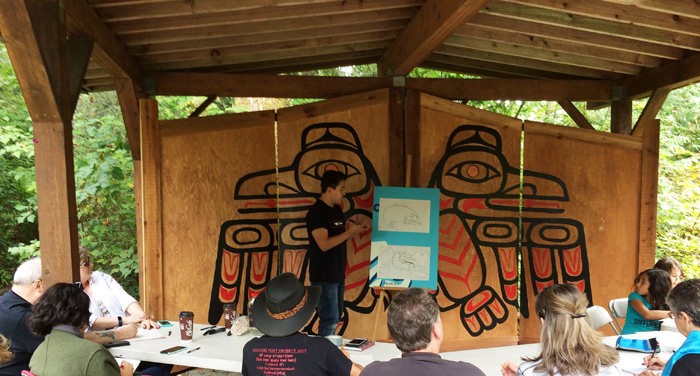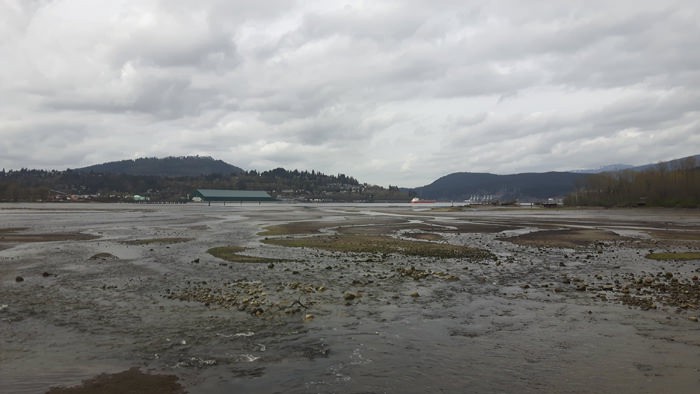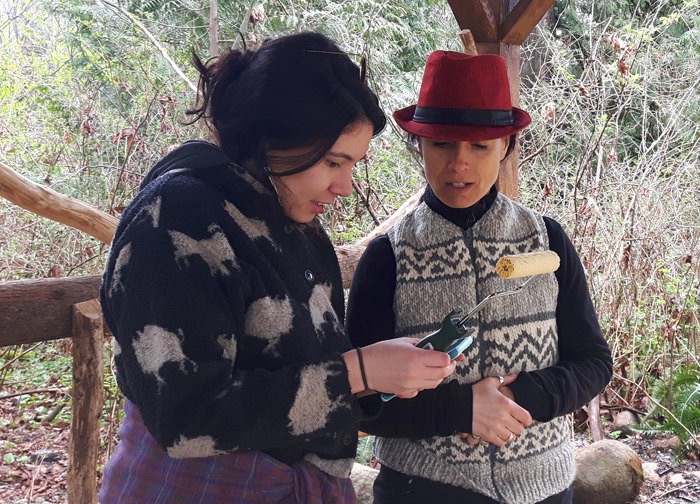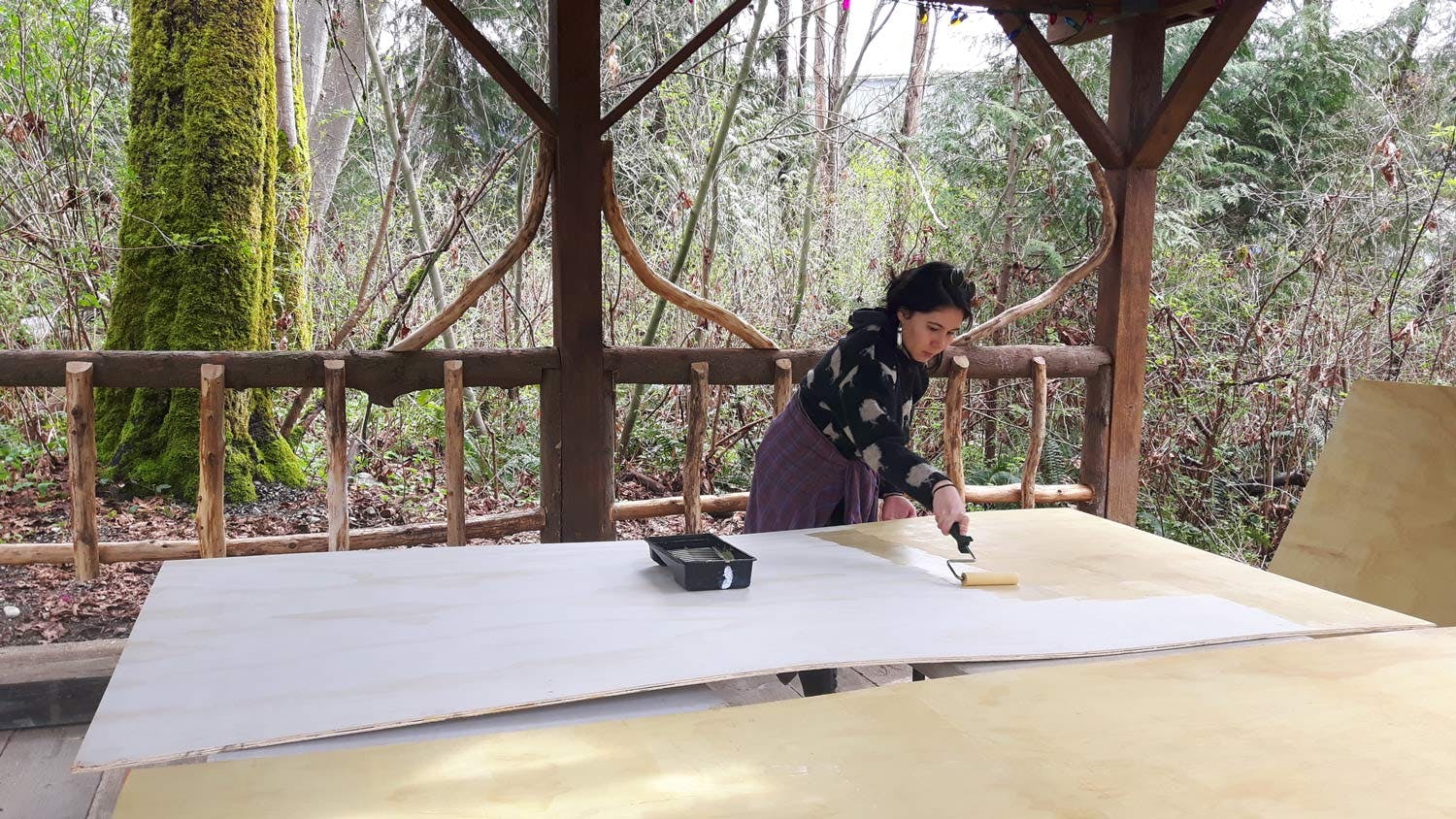Sharing her Gifts: A Q&A with Ocean Hyland
Before her Earth Week residency, this Indigenous artist/activist talks pipeline protests, language immersion, and reconciliation.
Ocean Hyland primes the panels she will paint as part of her Earth Week artist residency, at Noons Creek hatchery in Port Moody.
Ocean Hyland — an artist and activist from the Tsleil-Waututh Nation — gained international attention last month when Teen Vogue published her op-ed about participating in Protect the Inlet, the Indigenous-led movement against the proposed Trans Mountain pipeline expansion. On Earth Day (April 22), Hyland begins a weeklong artist residency at the Noons Creek salmon hatchery in Port Moody, as part of the Welcome Post Project.
Developed by Coast Salish artist Tasha Faye Evans, the project began on National Indigenous Peoples Day in 2017, offering a wealth of Indigenous cultural experiences in the Vancouver suburb. It will culminate after a year with the raising and blessing of a house post designed by Squamish carver James Harry, on June 21. Between now and then, community members can connect with Hyland while she works, participate in weaving workshops and ceremonies with other artists and leaders, and learn about the area’s Indigenous heritage.
The house post will be placed at the front of the hatchery’s gazebo, where Hyland’s artwork will be displayed during all 2018 Welcome Post events. I chatted with Hyland, 22, while she and Evans were priming the wooden panels she will paint during her residency. Our conversation ranged from her deepening knowledge of her history and culture, through to the future that anti-pipeline activists hope to protect with the watch house they have built on Burnaby Mountain. Hyland began by describing the design she is contributing to the Welcome Post Project. (This interview has been edited for length and clarity.)
Ocean Hyland: On each side is the salmon cycle: the egg and the alevin and the fry and the fully grown salmon. And then two human figures. They both have a fish inside. I’ve been told the name for this shared territory, Kwikwetlem, translates to “the red salmon people that go up the river.” That refers to the sockeye salmon. So we really wanted to incorporate the salmon into the design.
The male and female aspects of life will be represented [in the human figures]. And they have their hands raised in welcome and in gratitude. The male and female aspects of life coming together in harmony, the harmony of the salmon cycle too; it’s all about harmony and relationships and growth. The growth of the salmon, and the growth of this project, and how it’s grown connections in the community.
The idea of “shared territory” is about the natural resources of the area, and the relationship the people had with that. How they would all respect each other, and harvest in an ethical way. They would share it in a way that they knew who’s allowed to come and take what, and how much they could take. They knew they had to take care of the land.

Squamish carver James Harry giving a presentation in front of panels painted in Northwest Coast style, during 2017’s Welcome Post Project programming. This year’s Welcome Post events will feature Hyland’s Coast Salish design as backdrop.
Jessie Johnston: Can you talk about how you got involved with the Welcome Post project?
I had been studying as an artist at Native Education College, focusing on painting and drawing in Coast Salish style, and hand-engraving on copper and silver. I had made a drum in that program out of elk hide, and I’d painted a design on it. At my younger cousin’s birthday party, I gifted her the drum. It’s customary: the first [example] you make of something, you give away as a gift to someone that has taught you something. A gift back to them for the knowledge that you gained, to thank them.
And so I gifted it to my cousin Kayah, and Tasha was at Kayah’s birthday party. We were making smoothies and talking about the work both of us have been doing. How I’m interested in my language and my culture and my art. And she was talking about this project. So we had come together through family and community, and from there, she was like “I’d like you to come be a part of this project as a youth that is interested in their language and their art and their culture.” So that’s how I came to meet Tasha, through family. Smoothies and family.
Before we began, you and Tasha were checking in on what’s going on up Burnaby Mountain today. What has the experience of being involved with Protect the Inlet activism been like for you?
We’ve been talking about that as we were priming the first panels. We come at it from a very passionate place, because we love the land and we understand what it means to take care of the land. We’re learning what that means. That’s what makes us stand in those positions, to stand in that opposition.
Learning the technical jargon of the “economy world” has been a big learning curve for myself. I’ve been learning a lot about how my passionate point of view can play into those economists’ views, and how that can go alongside these big corporations. What’s really strengthening is finding these people who are doing the same work, and finding ways to work together where we all contribute our gifts to make Indigenous people’s stories be heard.
I have to drive 40 minutes to get here. But if I jumped in a canoe, it would take 15 minutes.
What’s the connection between your artwork and your activism?
I find that a lot of the time, my activism comes out in my artwork. I’m trying to tell my story as an Indigenous youth, my connection to the land, and why that’s important to me. And why I want that to be accessible for future generations, that connection to the land.
Of course, everyone interprets art in different ways, but that’s my hope and my goal. For it to create dialogue and thoughtful conversation around Indigenous stories, and connections to the land and what that can mean for communities. How people can start to understand and have their eyes open to what it means for an Indigenous youth to live on this land, and have that connection. How it can be threatened from these corporations, but how we can move forward and fight these big corporations and protest.
You’ve spoken a lot about your connection to the land writ large. Did you have a connection to this particular piece of land before the invitation from Tasha?
It is growing. I was laughing so hard about that when I was first coming out here, because I have to drive like 40 minutes to get here. But when I sit in my home [on the other side of Burrard Inlet], if I jumped in a canoe, it would take like 15–20 minutes. So I understand, back in the day, how close my ancestors would have been to their family over here, because they just had such easy access.
I’ve been learning so much. We had a nature walk with [Indigenous ethnobotanist] Cease Wyss, and that was really amazing. I got to see the shell midden of my ancestors, where they would harvest their clams, and eat their clams, and live their life around here.

The mudflats of Port Moody — where members of the Tsleil-Waututh and neighbouring First Nations historically harvested clams — are steps from the Noons Creek hatchery.
Your residency is starting on Earth Day. Does Earth Day have significance to you?
I find that funny because it’s only one day. I think it is a good day for people to come together and share stories about how they do celebrate Earth Day every day. I’ll be out here in the open on a public trail, so I’ll have those conversations. That’s the most important part, I’d say, talking to people. Earth Day should be every day.
One explicit goal of the work Tasha has been doing is around reconciliation. When you think of reconciliation, what do you envision?
When I think of true reconciliation, I think more so of Indigenous communities and their relationships to each other. Indigenous communities reconciling, and acknowledging: this is where our ancestors all came together. And when I see the work that Indigenous communities do to strengthen their relationships, acknowledging their shared territory, and doing work in ceremony together. But, other than that, I don’t know where I’ve seen true reconciliation, really.
What would it look like if you actually were seeing it? What is it that you haven’t seen?
I’d say, corporations and government acknowledging the damage that they’ve done truthfully, and actually taking action. After that step of acknowledging it, actually taking action to reconcile. Rather than not listening to Indigenous voices.
And making the changes that need to be changed. You see these Indigenous-led uprisings that have been happening — against the pipeline, the actions against missing and murdered Indigenous women — all being led by Indigenous people, asking for reconciliation and for action to be taken. And there’s not much coming back.
I find that funny because it’s only one day… Earth Day should be every day.
What’s next for you?
This summer I’m mainly focusing on my work here with the hatchery: my artist residency and the community engagement program. But also my work around the Watch House project [on Burnaby Mountain], going up and participating in ceremony and prayer. Because rather than calling it protest and fighting and rallying, I’d say it’s prayer and gatherings and ceremony. We sing songs, we walk for the Earth, and the land, and the animals, and the water, and the air. And do it in a peaceful way.
And then, just yesterday I had my exam for the Squamish language immersion program [at Simon Fraser University]. So I’ve been studying the Squamish language, and volunteering my time as part of a team that has been doing language lesson-building. I’ve just started canoe-pulling, as well, as if I wasn’t busy enough.
In the fall I hope to go back to school at SFU for the second year of the language program. The language has been really close to my heart this past year, because I’ve been so immersed in it. I’ve really carried it into the other work that I’ve been doing, like my activism.

While working in the Noons Creek hatchery gazebo, Ocean Hyland helps Tasha Faye Evans send the Squamish word for “sister” in a text message.
Whenever I go up to the mountain or do interviews up there, I always try to say a little bit of language, and introduce myself in that language. And then when I’m doing my artwork, titling my work in the language. When I paint and I draw, I talk to myself in the language to practice. So it’s really been drenched into my life, because I’ve been immersed in the Squamish language for 8 months straight.
Those are my three main focuses this summer: art, activism, language. And canoe-pulling.
I’ve also joined a youth committee within my nation. We’re joining together so we can talk about the work the people in our elected positions are doing, and what that means for youth. How to become educated to fill those positions when they get to that age. And what ways we can educate youth coming up, and get to a place where we can start having our voice heard on a voting level in our community. Getting youth together to share our gifts.
And acknowledging that the work our parents are doing, and our grandparents have done, was for us. So we’re talking about the work they’ve done, and — when it’s our time to start making those decisions and those plans — what we want to see for future generations. Acknowledging that, seven generations behind, they did stuff for us. So those seven generations to come, we want to be able to do good work so that benefits them.
